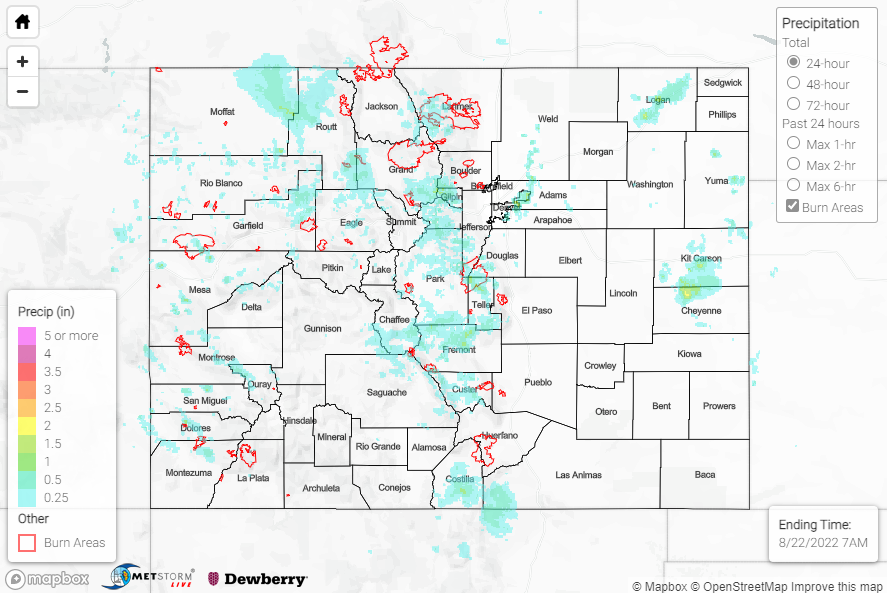Issue Date: Monday, August 22nd, 2022
Issue Time: 11:00 AM MDT
Summary:
Sunday featured a similar pattern and similar weather compared to Saturday, with the heaviest rain falling from the Grand Valley eastward into the Urban Corridor, particularly to the south and east of Denver. Showers and storms developed by early afternoon over the high terrain and moved off into the foothills later in the day. Development was aided by an upper-level trough that pushed into northwest Colorado and provided synoptic lift, while faster flow associated with this trough yielded slightly faster storm motions and therefore a slightly lower flash flooding threat compared to previous days.
Out west in the Grand Valley, QPE data suggests localized amounts up to 1.50”. A Flash Flood Warning was issued for the Pine Gulch burn scar, while three other Flood Advisories were issued across Mesa County near Grand Junction; no flooding was reported in any of these locations. Rain gauge coverage is sparse, but an automated station northwest of Grand Junction measured 0.67”.
Moving eastward across the Central/Northern Mountains and into the Front Range, QPE data suggests more widespread totals approaching and exceeding 1.50”. A Flash Flood Warning was issued for the Grizzly Creek burn scar, while Flood Advisories were issued for both the East Troublesome and Cameron Peak burn scars; thankfully, no flooding reports were received. Notable rainfall reports include a CoCoRaHS observation of 1.15” northwest of Kremmling, and an automated station observation of 0.70” west of Estes Park.
Across the Urban Corridor, a line of convection along and east of I-25 produced a corridor of heavy rainfall from Greeley south to Aurora, with QPE data suggesting amounts up to 2” near Aurora. This rainfall prompted a Flood Advisory for portions of the Denver metro, with Denver Airport recording 1.14”. This total broke the daily rainfall record for August 21st and was also the first day in almost a year and a half that DIA measured more than 1” of precipitation! Other notable rainfall totals from automated stations include 1.26” and 0.83” near Aurora and Greeley, respectively.
💦 Daily Record Rainfall at Denver Today 💦
With 1.14″ of rain this afternoon, Denver has broken it’s daily rainfall record. The previous record was set in 1958, when 0.99″ fell.
This is also the first time since March 14th, 2021 where over an inch of precipitation fell. #cowx pic.twitter.com/kKk92FyqH7
— NWS Boulder (@NWSBoulder) August 22, 2022
Farther south across the San Juans and Southeast Mountains, QPE data suggests amounts of 0.50-1.00”. Out east across the Plains, isolated storms produced locally heavy rainfall across portions of Logan, Kit Carson, and Cheyenne Counties, where QPE data suggests amounts up to 2”.
If you observe flooding in your area, remember to use the “Report a Flood” page to make any flood reports when you can safely do so. For precipitation estimates in our area, check out the map below.
